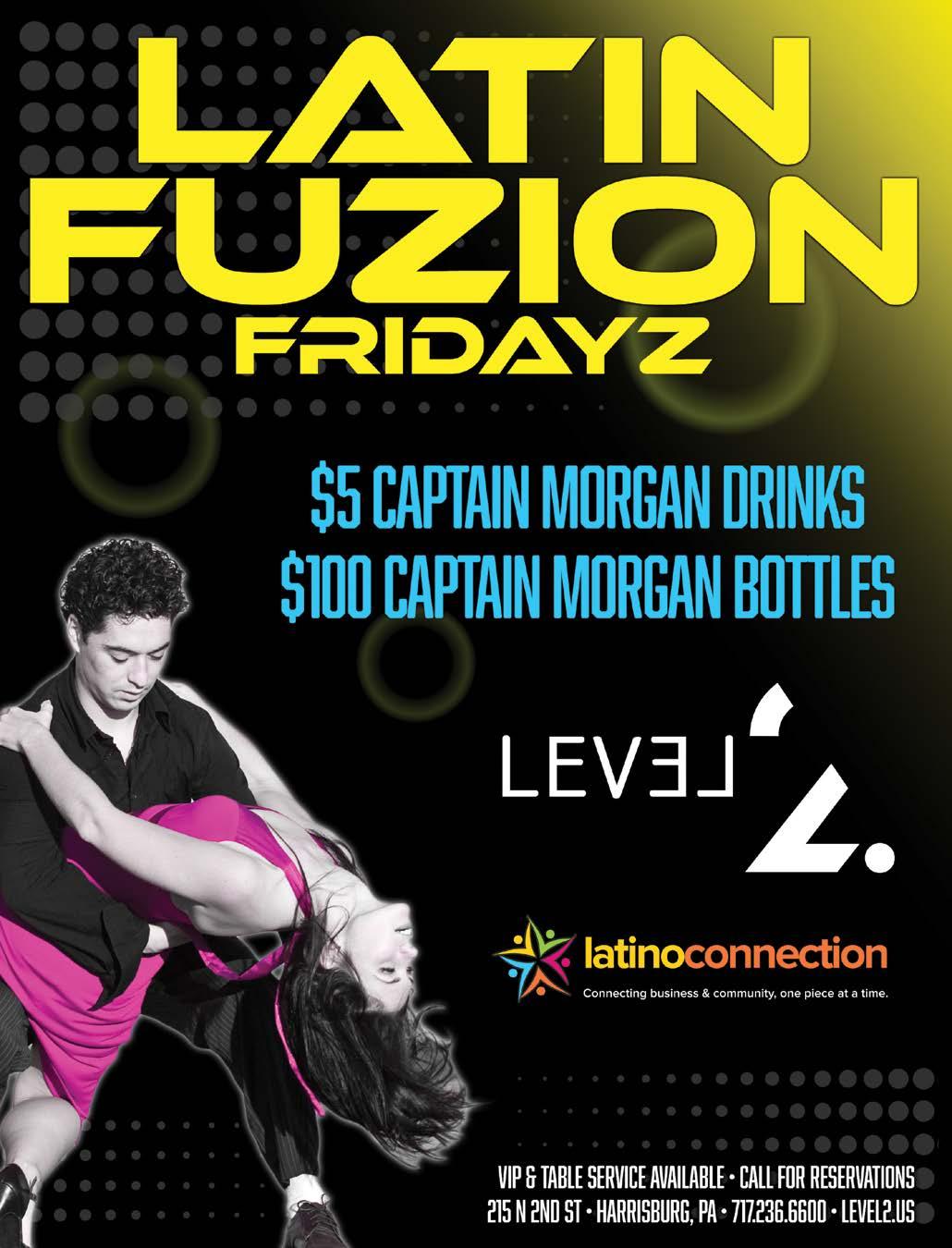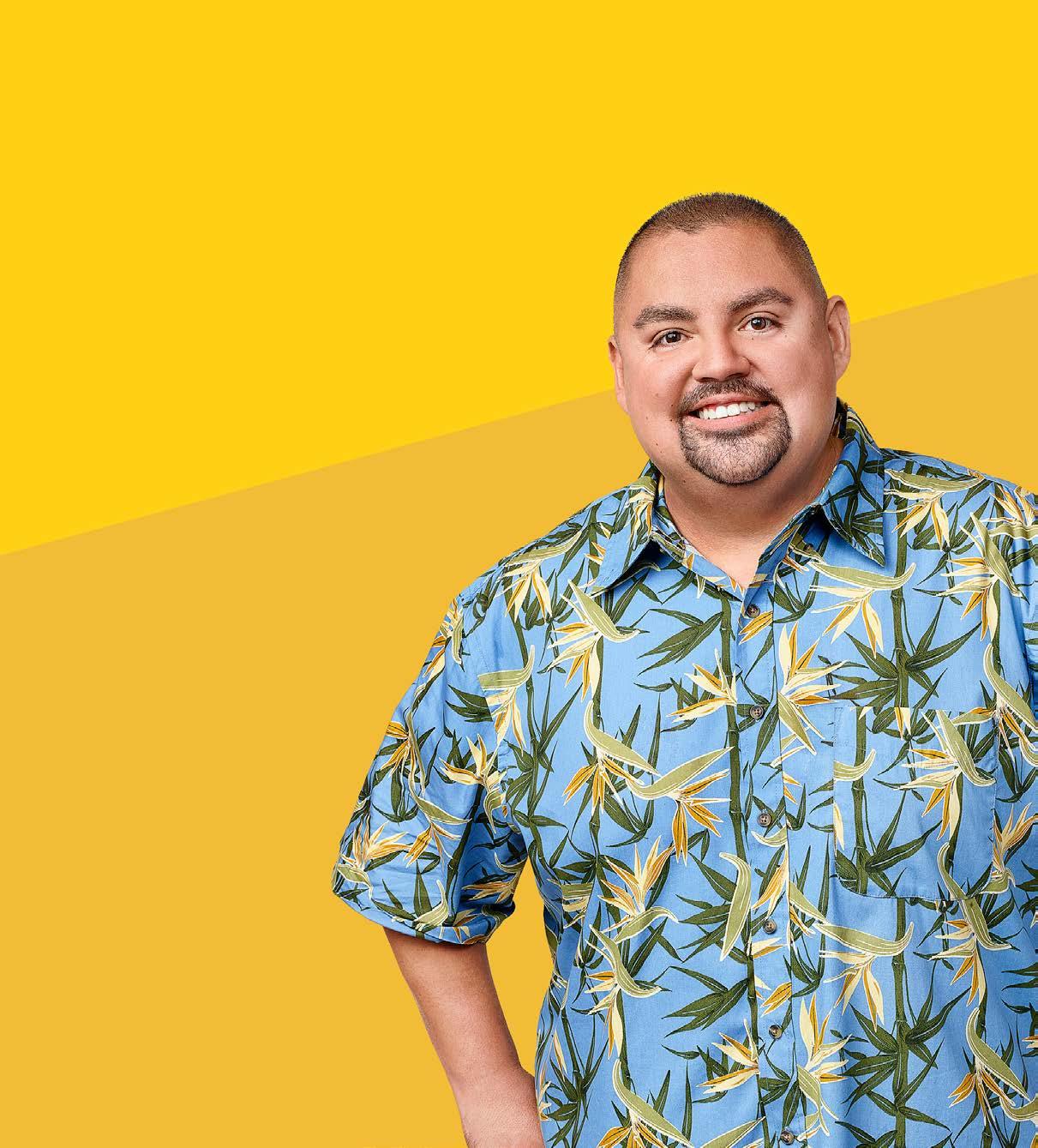

FEB-MAR ‘16 Gabriel iGlesias aKa "FlUFFY" aND serGio varGas 2 TlC eXClUsive iNTervieWs Hispanic Heritage Foundation: Educating and Mentoring Latinos Fundación Herencia Hispana: Educando y Orientando Latinos BoriquaChicks.com An Afro-Latina Perspective Ismael Torres-Castrodad: First March of Dimes Ambassador from Puerto Rico Online Investing With Pura Inversión En Línea Con Pura Love Begins with Loving Yourself First El Amor Comienza Amándote A Ti Misma
Photo of Gabriel Iglesias by Justin Stephens
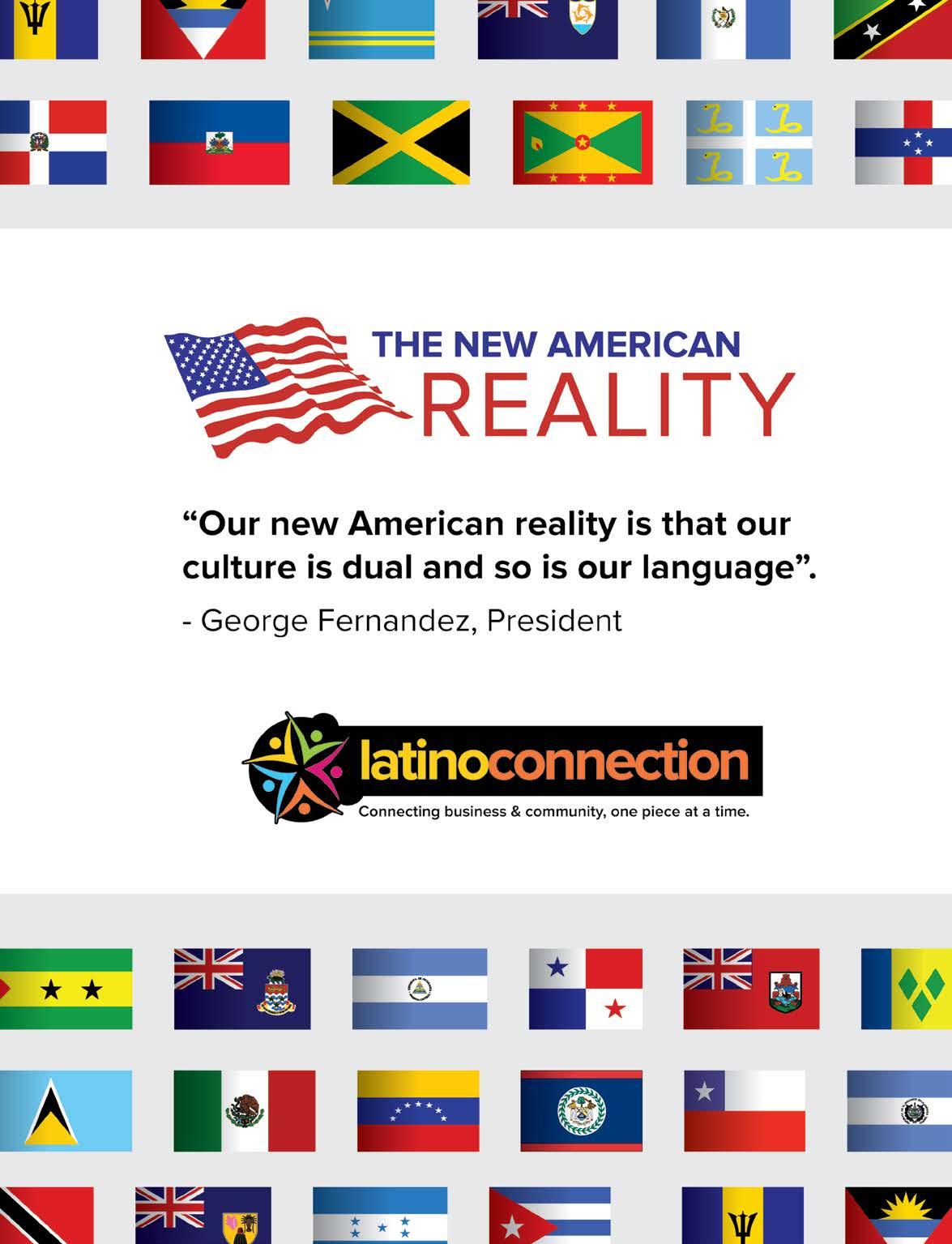
George Fernandez
Publisher
Judy Cuevas
Editor-In-Chief/ Editora Encargada
Jesus Cuevas Peña
Assistant Editor and Guest Writer/ Editor Asistente y Escritor Invitado
Pura Rivera
Columnist / Columnista

Pedro De La Cruz-Valdez
Account Executive / Ejecutivo De Cuenta

Sara Snow and Raquel Parham
Guest Writers /Escritoras Invitadas
Claire Behney, Gio Acosta
Contributing Photographers / Fotógrafos
Katherine Vargas
Publisher's Assistant/ Asistente al publicador
Marcela Mortensen
Director of Sales and Marketing/ Directora de Ventas y Mercadeo
Michelle Connett
Art Director / Directora Artística
Jean Cubilette
Social Media Analyst / Analista de Medios Sociales
Corporate Office
Market
3 4 Publisher’s Note: The New American Reality La Nueva Realidad Americana 6 ¡Caliente Online! 8 Sergio Vargas: Legendary Merenguero 12 Hispanic Heritage Month FundaciÓn Herencia Hispana 16 Gabriel "Fluffy" Iglesias T H e L ATINO C ONN e CTION MAGAZIN e T able o F C o NT e NT s CO nn ECT WITH us @latinoconnectpa @latinoconnection @latinoconnection Call Us! (717) 963-7218 Share your opinions and thoughts with us. Write to us today. Comparta sus opiniones y pensamientos con nosotros. Escribanos hoy. info@thelatinoconnection.net Visit our webpage today! Visite nuestra página web! www.thelatinoconnectionmag.net @latinoconnection
& CEO / Editor Y Presidente
Co
e CT
N M a G a Z i N e 20
An Afr0-Latina
23
26
29
112
Street . Suite 430 Harrisburg, PA 17101 TH e l a T i N o
NN
io
BoriquaChicks.com -
Perspective
Ismael Torres-Castrodad: March of Dimes Ambassador from Puerto Rico Embajador de Puerto Rico
Online Investing with Pura Inversion en Linea con Pura
Love Begins with Loving Yourself First El Amor Comienza Hacia Ti Mísma
P UBLISH e R ’ S NOT e:
T H e Ne W aM eri C a N r eali TY l a N U eva r eali D a D aM eri C a N a
This year, instead of making a resolution, I decided to make a commitment – to education. As the Latino population grows, we need to come together on topics of health, family, business, and education. We need to become a stronger and unified voice. I was once told that, “every opportunity begins with education.” Throughout my life, I have crossed paths with people who gave me opportunities and I want to pay it forward. My desire is that my community becomes educated.

Call me a dreamer, but I still believe that America is the land of opportunity. I don't want to stay comfortable in my position and I hope that others feel the same way. I wish that we would strive for our dreams as if our lives depended on it. Along with education, I think of the word, “commitment”. They go hand in hand, as we have to be committed to stay on course in our educational paths in order to strive for better. To you, I say continue on your path to want more out of life. Above all, do not settle. Continue to educate yourself and help others along the way. The Latino Connection Magazine will do its part by educating you on organizations that are helping our Latino community succeed.
For our first issue of the year, we are honored to feature one of our favorite comedians, Gabriel “Fluffy” Iglesias, who will be hosting three comedy shows in Pennsylvania in April 2016. We hope that you will consider supporting our artists who come to our state to entertain us. In addition, we are pleased to announce that we have a second interview with famous Merenguero, Sergio Vargas. He describes his love for his country of the Dominican Republic.

We also want to thank the Boriqua Chicks for sharing their passion about being Afro-Latina. Since February is AfricanAmerican History Month, we wanted to include a different perspective.
We also feature the March of Dimes National Ambassador, Ismael Torres-Castrodad, a 13-year-old Puerto Rican young man with a fascinating story. Once again, our friend Pura Rivera brings us a piece of her expertise, or as she like to put it, “her hobby,” online investing.
We also want to thank our sponsors, advertisers, and readers who have remained with us from the beginning to 2016. We would not be here without you. As always we hope that you enjoy The Latino Connection Magazine as we bring it to you for your enjoyment and educational enrichment.
Este año, en vez de una resolución, decidí más bien hacer un compromiso con la educación. A medida que la población latina crece, necesitamos unirnos en temas de salud, familia, negocios y educación. Necesitamos tener una voz más alta. Una vez me dijeron, y he dicho muchas veces desde que lo escuché, que “toda oportunidad empieza con la educación”. A lo largo de mi vida mucha gente que se ha cruzado en mi camino me ha dado oportunidades y quiero retribuirlas. Mi deseo es que mi comunidad se eduque.
Llámenme soñador, pero todavía creo que América es la tierra de las oportunidades. No quiero permanecer cómodo en mi posición y espero que otros sientan lo mismo. Deseo que nos esforcemos por nuestros sueños, ya que de eso depende nuestra vida. Junto con la educación, pienso en la palabra compromiso. Por nuestra parte, The Latino Connection Magazine se comprometerá a instruirlos sobre las organizaciones que están ayudando a la comunidad latina a triunfar en todo el sentido de la palabra.
En nuestra primera edición del año, tenemos el honor de presentar uno de nuestros comediantes favoritos, Gabriel “Fluffy” Iglesias, quien tocará en tres conciertos diferentes en Pensilvania en abril de 2016. Esperamos que piensen en apoyar nuestros artistas, que vienen a nuestro estado a entretenernos. Además, nos complace anunciar que tenemos una segunda entrevista con el famoso merenguero Sergio Vargas, que describe el amor por su país, la República Dominicana.
También queremos agradecer a la bloguera de Boriqua Chicks por el artículo sobre su experiencia por ser afro-latina. Como febrero es, tradicionalmente, el mes de la Historia Afro-Americana, quisimos compartir una perspectiva diferente.
Presentamos también el Embajador Nacional de “March of Dimes”, Ismael Torres-Catrodad, un joven puertorriqueño de 13 años con una historia fascinante. Una vez más, nuestra amiga Pura Rivera nos trae un poco de su pericia o, como le gusta decir, “su pasatiempo”, invertir por la red.
Queremos agradecer a nuestros patrocinadores, anunciantes y lectores que se han quedado con nosotros en 2016. No estaríamos aquí sin ustedes. Como siempre, esperamos que disfruten The Latino Connection Magazine, ya que se la llevamos para su esparcimiento y enriquecimiento educativo.
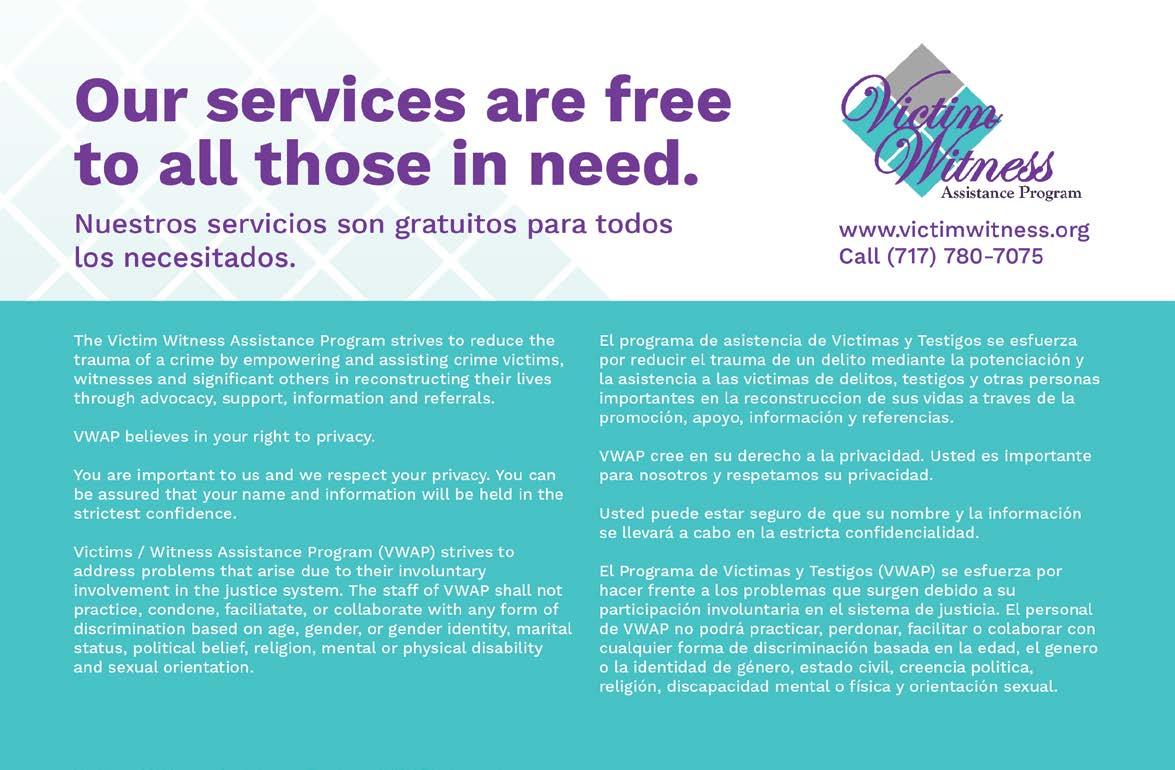
4
“Learning is not attained by chance, it must be sought for with ardor and diligence.”
A BIGAIL ADAMS
“El aprendizaje no se consigue por casualidad, debe ser buscado con ardor y diligencia.”


Dominican Republic's Independence Day is on February 27th. Why not visit this beautiful island? Check out the DR Ministry of Tourism's Twitter page: @godominicanrepublic
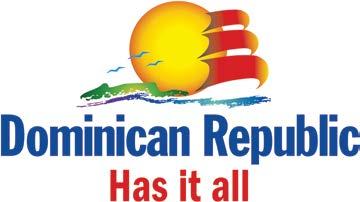

Found on: Twitter
Ok, we admit it some of us are geeks who JUST CAN'T WAIT for this movie to come out. Batman vs. Superman: Dawn of Justice is coming out March 2016.

Found on: YouTube
BY JUDY CUEVAS

We love ART, all kinds of ART!! We found this Chicano piece surprisingly done by an artist from Holland by the name of Claudia Hek.
Found on: Pinterest


We just love this classic bridal look. Taken by @forksnbrides
Found on: Instagram
This is not your mother's high school. "east Los High," an online teen drama original on Hulu, follows a group of Latino teens living in East Los Angeles.


Found on: Hulu
Learn how to make a no-bake banana split cake on Buzzfeed Food's Facebook page. Mmm delicioso!!!
Found on: Facebook
6

S e r gi o Va r g a s
Hispaniola is the only island in the world hosting two nations, and this coming 27th of February, the celebration on occasion of the 172nd anniversary since the island divided into two nations, the Dominican Republic and Haiti, will take effect. This is why we decided to interview a musical icon of the Dominican Republic, whom since the 80's has kept the merengue culture – the musical genre native to the Dominican Republic – alive.
TLC: The lyrics in your songs in some way have always caused the public to get emotional and relate; what inspires you to compose your songs?
SV: Among my most famous songs, almost none of them are my work, because I consider myself a very grounded person, and though I compose on occasion, in order to record an album, I’ve always “grabbed the bull by the horns” and have sought out advice from the experts in the matter, because my strong suit -truth be told- is to sing, though the core of the music business is WHO is calling the shots when it comes to A&R.
Each of my songs is carefully selected, using high- standard values and respectbased criteria. I would never give rhythm to bullying or issues on the denigration of women, the environment, family or its values, I’ve never done it before, and it has felt good to not do so.
TLC: Despite your fame, you have kept on being a humble and close-tohome native of your province (Villa Altagracia), have you ever imagined yourself living elsewhere in the future?
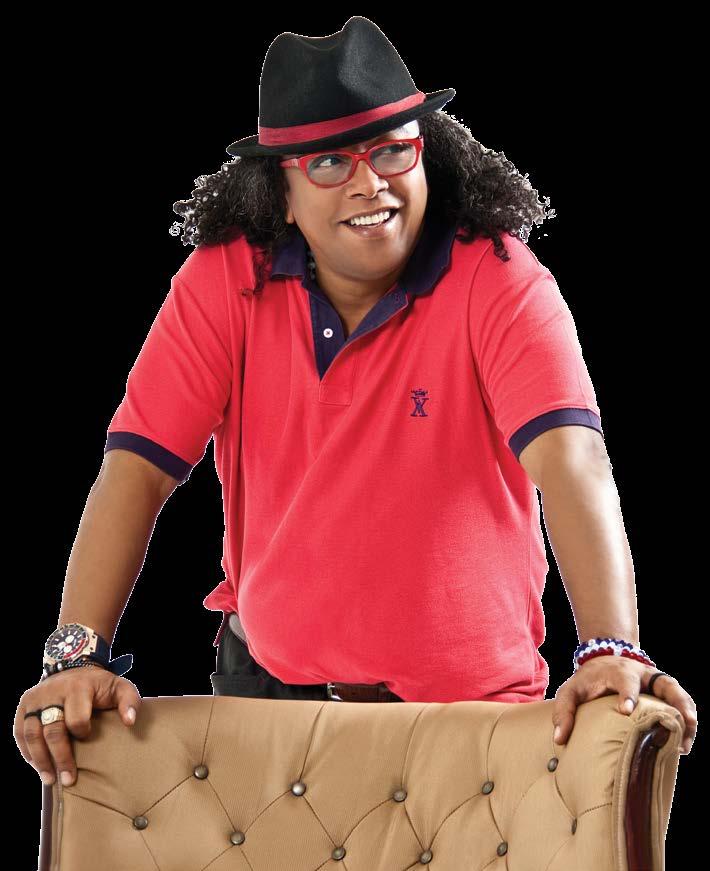
SV: No, there’s no chance of that.
TLC: The way you wear your hair; it has become a general assumption that it is a personality trait of the artist, but in a recent interview, I noticed you haven’t cut it as signs of protest against the Dominican government for their neglect in repairing the streets of Villa Altagracia; do you think that someday you will meet that goal and Sergio Vargas will cut his hair again?
SV: I can assure you that my attitude is not one of protest but more of rebelliousness. I live in the town that saw me born with over one hundred thousand residents. Not one thing has been funded by the State that would provide employment opportunities to those youths fresh out of college. I also let my image speak for itself, and in the way that it catches public attention. I hope it serves as reminder that in my town, Villa Altagracia, also live people and that we are as Dominican as any other born in the capital cities where the State invests vastly in.
8
Le G e NDARY Me R e NGU e RO AND S ON OF D OMINICAN Re PUBLIC
TLC: Aside the singing career, was there any other career that appealed to you?
SV: You know, I haven’t yet finished college, but I always dreamed of majoring in Business.
TLC: Which has been your favorite performance and why?
SV: Each of my performances have been a completely different experience from the other. I think that back in 1988 with just one merengue that hit the Top 10, I did a concert in the Altos de Chavón amphitheater, and we broke the attendance record ever to take place until then. In a venue where artists such as Frank Sinatra, who actually inaugurated the amphitheater, this was one of the events that got to me the most. I’ve been the artist that has performed the most concerts there, already 11 to this day.
TLC: Sergio Vargas is a loving and loyal son to his Dominican Republic, and usually wears dresses wearing the colors of his Fatherland. However, there are many fellow Dominican artists that have achieved international fame, and are constantly offering performances abroad, but seldom perform concerts in their hometown. What’s your take on that?
simpleton in a country where there are so few opportunities as is ours, it is already a great achievement. When I didn’t have two dimes to rub together, and lacked the basics such as food and clothing. Now everything is booked and though living “peacefully”, people now distance themselves further from God, families break up. I never saw this when I was just another in the crowd, but we need to face the fact that life goes on. This Christmas I was asked to send a message to the population, and the only thing I wanted to express to everyone was that this is the moment to give back to God. We spend every day asking Him for things, and on our end, with just simple acts of kindness and forgiveness, we are giving God one of the gifts He values the most, but people only ask and are insatiable. And another is that God is loved in silence, to any person that eats in my table, I do so in the utmost silence, emulating God.
TLC: Had you not been a merengue performer, what musical genre would you have chosen?
SV: Had I not been a merengue performer, perhaps a bolero singer. Though merengue runs in my blood, is our emblem rhythm and has over 80 years of history. Early in the century, merengue was already a beat danced to in the agricultural fields and in the
SV: The fundamental part of a man’s life has much to do with his origin. Where he was born and raised, his childhood friends, we all have to bear with our past and some dread it. Even I sometimes understand it, because there’s nothing to look for in the past, but pity the one that forgets their background. Because they end up without a home to go to, and this also shows ungratefulness and human misery. A person that speaks differently from how they live, can’t have public credibility.
TLC: Since your early years, you’ve gone through a series of hardships, such as witnessing your mother’s death at the tender age of six, having to provide for your family since you were very young. Would Sergio Vargas today, change anything about his past?
SV: No, I wouldn’t change a thing. I was happier when I was hungry. The struggle to keep competing and as just another
regions where the slave colonies had set. Merengue made its grand debut in the times of President Trujilllo, for he was its grand benefactor and even commissioned merengue performances for his parties and tailoring of his suits. It is something that will exist forever in the history of this genre.
TLC: What are your plans for the future, do you have any upcoming project?
SV: What interests me is to stay alive in the midst of all that is going in the world, and not just physically but also in the moral aspect. We need to maintain our public credibility, because without it, we are worth nothing. If tomorrow the people say “no more Sergio Vargas”, I’m prepared to live physically, morally and mentally from anything that will allow me to fend for myself and
family.
9
my
“The struggle to keep competing and as just another simpleton in a country where there are so few opportunities as is ours, it is already a great achievement.”
s er G io v ar G as
La hispaniola es la única isla del mundo que tiene dos países, y el día 27 de este mes de febrero se celebra la independencia de República Dominicana, es la fecha en donde esta isla se divide en dos países que son República Dominicana y Haití. Es por esto que decidimos entrevistar a un emblema nacional de esta isla, el cual desde principios de los años 80' ha mantenido viva la cultura del merengue, la música típica de República Dominicana.

TLC: La letra de sus canciones de cierta manera hacen que el público se emocione y se identifique con ellas, ¿qué lo inspira a usted a escribir sus canciones?
SV: De las famosas que tengo casi ninguna son mías porque pienso que soy una persona muy aterrizada, y aunque escribo en ocasiones, para hacer un disco siempre he tomado el toro por los cuernos, me dejo asesorar de mentes especializadas en esa materia porque el fuerte en mí es cantarlas aunque la parte delicada en el negocio de la música es quien está al mando del repertorio.
Cada una de mis canciones es seleccionada cuidadosamente con un alto criterio de los valores y respeto al público, yo nunca usaría la güira y la tambora para cantar nada que hable feo de la mujer, del medio ambiente, de la familia o de los valores, jamás lo haría, y me ha hecho bien hacer esto.
TLC: A pesar de su fama, se ha mantenido con una personalidad humilde y apegado a su provincia natal (Villa Altagracia), ¿se imagina viviendo en un lugar diferente a este en un futuro?
SV: No, no hay ninguna posibilidad de eso.
TLC: La forma de su pelo se asume como parte de la personalidad del cantante, pero en una entrevista reciente, vi que no se lo corta como forma de protesta hacia el gobierno dominicano para que reparen todas las calles de Villa Altagracia, cree que algún día pueda lograr su propósito y Sergio Vargas vuelva a cortarse el pelo?
SV: Yo te puedo asegurar que mi actitud no es de protesta sino más bien de rebeldía, yo vivo en el pueblo donde nací con más de cien mil habitantes donde no hay nadie ni nada financiado por el Estado que permita siquiera suplirle empleo a aquellos jóvenes recién graduados de la Universidad, también dejo que mi imagen hable y que a medida que mi apariencia le llame la atención a cualquiera, ésta ayude a recordar que en mi pueblo Villa Altagracia también vive gente y que somos dominicanos igual que los que han nacido en grandes centros de la población donde hace grandes inversiones el Estado.
TLC: ¿Alguna vez le llamo la atención otra carrera además de ser cantante?
SV: Sabes que no me he graduado de la Universidad pero la carrera que siempre me gusto a mí fueron los negocios.
TLC: ¿Cuál ha sido su presentación favorita y por qué?
SV: Es que cada una de las presentaciones es una experiencia totalmente diferente una de la otra, yo creo que en el año 1988 con un solo merengue reconocido hice un concierto en Altos de Chavón bajo lluvia y rompimos el récord de asistencia que había tenido ese lugar hasta ese momento, en un espacio físico donde han cantado grandes artistas como Frank Sinatra que fue quien lo inauguró, ese fué uno de los eventos que más me ha marcado , he sido el que más conciertos ha dado en ese lugar, llevo 11 (once).
TLC: Sergio Vargas es una persona que le ha sido fiel a su tierra, República Dominicana, y usualmente viste prendas que representan la bandera de su país, sin embargo, hay varios cantantes dominicanos que han creado mucha fama internacional y se mantienen constantemente ofreciendo grandes conciertos en países extranjeros, pero muy rara vez hacen conciertos en su tierra, ¿cuál es su opinión sobre eso?
SV: La parte radical de la vida de un hombre tiene que ver con su origen, donde nació, donde se crió, los viejos amigos, todos tenemos que vivir con nuestro pasado y algunos le tienen terror a eso, yo incluso a veces lo entiendo porque no hay nada que ir a buscar al pasado, pero pobre de aquel que olvida de donde viene porque regularmente se queda sin un lugar a donde llegar, eso también es muestra de ingratitud y miseria humana, una persona que habla diferente a como vive no puede tener credibilidad pública.
TLC: en su vida desde su nacimiento usted ha pasado por cosas muy duras como presenciar la muerte de su madre cuando tenía solo 6 años, el tener que sustentar a su familia desde joven, entre otras cosas. el Sergio Vargas de hoy en día, ¿cambiaría algo sobre su pasado?
SV: No, no cambiaría nada. Yo era más feliz
cuando no tenía con que comer; la batalla por mantenernos en la competencia y como uno más en un país con tan pocas oportunidades como el nuestro es una proeza, yo cuando no tenía en que caerme muerto lo que me faltaban eran cosas básicas como ropa y alimento, ahora tenemos todo comprometido y viviendo en la “tranquilidad”, ahora la gente se aleja más de Dios, cada día los grupos familiares están más distribuidos, eso yo no lo veía cuando yo era una persona desconocida, pero tenemos que afrontar que la vida sigue su curso. En estas navidades me pidieron dar un mensaje a la población y lo único que quise expresar a todos fue que es el momento de darle algo a Dios, nos la pasamos día tras día pidiéndole cosas y nosotros con el simple hecho de ser solidarios, desprendidos y con practicar el perdón, le estamos haciendo a Dios uno de los regalos que más valora, pero la gente solo pide y es insaciable; y otra cosa es que a Dios se le quiere en silencio, yo a cualquier persona que se sirva de mi lo hago en estricto silencio para copiar a Dios.
TLC: De no haber sido merenguero, ¿qué género musical le habría gustado interpretar?
SV: De no haber sido merenguero me habría inclinado por el bolero, aunque mi identidad es el merengue, es nuestro emblema nacional y tiene más de 80 años de historia, a principios de siglo, ya en nuestro país se bailaba merengue en los campos y en las regiones donde habitaban los esclavos, el merengue hizo su gran lanzamiento en la época del presidente Trujillo, este señor fue su gran protector e incluso mandaba a hacer merengues para sus grandes fiestas y para confeccionar sus trajes, es algo que quedará marcado en la historia del merengue.
TLC: ¿Cuáles son sus planes para el futuro? ¿Tienes algún nuevo proyecto?
SV: Lo que me interesa es mantenerme vivo en medio de todo lo que está sucediendo en el planeta, y no solo físicamente sino también en la parte moral, necesitamos mantener la credibilidad pública ya que sin esto no valdríamos nada. Si mañana la gente dice no más Sergio Vargas yo estoy preparado para vivir física, moral y mentalmente de cualquier otra cosa que me permita sostenerme a mí y a mi familia.
10 Español
e L HIJO D e V ILLA Y L e G e NDARIO M e R e NGU e RO DOMINICANO

H ispa N i C H eri T a G e F o UND a T io N

The Latino Connection is going to challenge everyone reading this article to do one thing today. EDUCATE yourself about the Hispanic Heritage Foundation (HHF). WHY? HHF could directly benefit a Latino youth that you know. Much like the American Cancer Society educates the public on cancer, HHF helps educate and mentor Latino youth from elementary school to career professionals. HHF is a national nonprofit which inspires, prepares, positions and connects minority leaders in the classroom, community and workforce to meet America’s priorities. Through HHF’s Code as a Second Language Initiative, thousands of Latino students across the nation, K-12, are introduced and taught to code. Participating students are then funneled into and tracked by HHF’s award-winning LOFT (Latinos On Fast Track) workforce development program for further development, connectivity and placement into the workforce.
Each year HHF provides grants in different categories: Business & Entrepreneurship, Community Service, Education, Engineering & Mathematics, Healthcare, Innovation & Technology, and Sports & Fitness. Three awards for each student category and one Innovative Educator Award are given in each of the ten regions across the country. Locally, our closest regions are in New York and Washington D.C. respectively. One Regional Award winning student from each category and one Innovative Educator will be selected as the National Youth Award recipient in his or her respective category.
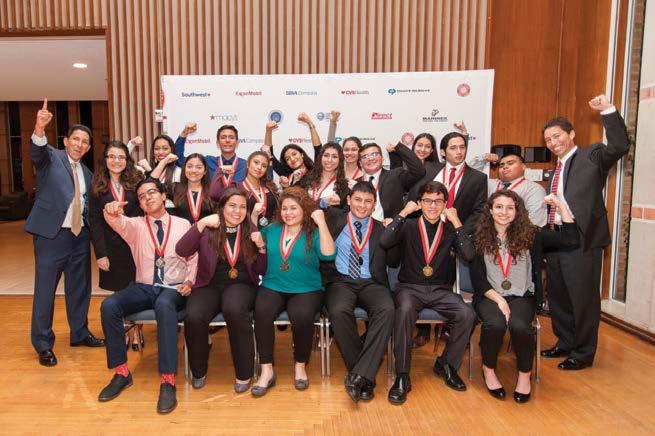
The Latino Connection concentrated its attention on the Innovation & Technology Track, a Track which in particular focuses on three platforms: 1) Technical training to get Latinos into Technology; Instruction of Computer Programing; Code as a Second Language; 2) Providing Conferences and Summits geared for both professionals and students who are majoring in computer sciences 3) Working with companies to assist talent in obtaining jobs within their field through a program called LOFT Source.
An average of 70% of the students who have taken the workshops want to continue with computer programming, and while our goal is not to make everyone an engineer, we want to expose them to it and give them access to the technology,” states Alberto Avalos, Innovation & Technology Program Manager. “Nine out of 10 schools don't teach it or provide it as an option, so what we tell [students] is
that just understanding computer science elevates your profile 100 times”, adds Avalos.
Our goal in this magazine is to educate the public on the resources available to the Latino community. We proudly featured HHF because we believe in its mission and goals. HHF is there to help our Latino youth today. At the start of this article we challenged you to educate yourself on HHF, now we challenge you to think of several young people in your life you think would benefit from knowing about HHF. Tell them, either by Facebook, Instagram, Twitter, text, email, however you must to start the conversation that HHF exists and can be a source of assistance towards their goals.
To apply for grants or simply to learn more about Hispanic Heritage Foundation, friends, educators, parents, and students can visit www.hispanicheritage.org.

12 e DUCATING
AND M e NTORING LATINOS FROM e L e M e NTARY TO PROF e SSIONALS



Y O RI e NTANDO L ATINOS D e SD e LA P RIMARIA HASTA P ROF e SIONAL e S
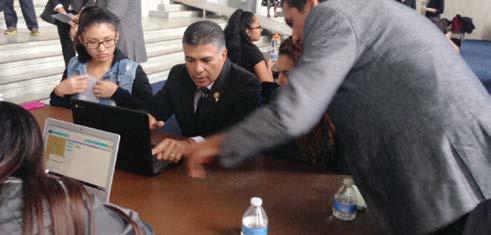
F UND a C ió N Here NC ia Hispa N a
The Latino Connection va a desafiar a todos los que lean este artículo a hacer algo hoy. INFORMARSE sobre la Fundación Herencia Hispana (HHF, por Hispanic Heritage Foundation ). ¿POR QUÉ? La HHF podría beneficiar directamente a un/a joven que usted conozca. Muy parecida a la forma en que la Sociedad Americana del Cáncer educa al público sobre el cáncer, HHF ayuda a educar y a orientar la juventud latina desde la escuela primaria hasta las carreras profesionales. HHF es una institución nacional sin fines de lucro que inspira, prepara, posiciona y conecta líderes minoritarios en el aula, la comunidad y la fuerza de trabajo para llenar las prioridades de América. Mediante el programa, Código como Segundo Idioma de HHF, miles de estudiantes latinos en toda la nación, K-12, se les presenta y se les enseña el código. Los estudiantes participantes luego se hacen pasar y se les rastrea por el programa de desarrollo de la fuerza de trabajo para mayor desarrollo, conectividad y colocación en el mercado de trabajo de HHF, ganador del premio LOFT (Latinos On Fast Track).
Cada año, HHF hace donaciones en categorías diferentes: Negocios y Emprenderismo, Servicio Comunitario, Educación, Ingeniería y Matemáticas, Atención a la Salud, Innovación & Tecnología, y Deportes & Buena Forma. Se dan tres premios para cada categoría de estudiantes y un Premio al Educador Innovador, en cada una de las diez regiones del país. Localmente, nuestras regiones más cercanas están en New York y Washington D.C., respectivamente. Se seleccionará un estudiante ganador del Premio Regional en cada categoría y se seleccionará un Educador Innovador en cuya respectiva categoría se haya entregado el Premio Nacional de la Juventud.
The Latino Connection concentró su atención en el Grupo de Innovación & Tecnología, un Grupo que se concentra particularmente en tres plataformas:
1) Entrenamiento técnico para que los latinos aprendan Tecnología; Instrucción de Programas de Cómputos; el Código como Segundo Idioma; 2) Proporcionar Conferencias y Cumbres dirigidas tanto por profesionales como por estudiantes que se están especializando en ciencias de cómputos; 3) Trabajar con compañías para ayudar a que el talento consiga trabajo dentro de su campo mediante un programa llamado Fuente LOFT.
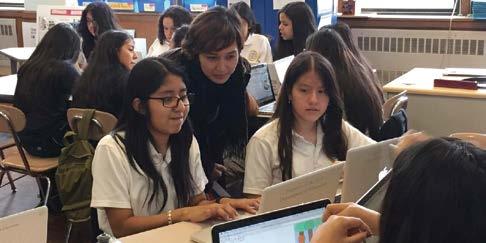
“Un promedio de 70% de los estudiantes que han hecho los talleres quiere continuar con programas de cómputos, y como nuestra meta no es hacer ingeniero/a a todo el mundo, queremos exponerlos y darles acceso a la tecnología”, declara Alberto Avalos, Gerente deI Programa de Innovación & Tecnología. “Nueve de cada 10 escuelas no la enseñan ni la ofrecen como opción, de manera que lo que decimos (a los estudiantes) es que sólo
entender la ciencia de las computadoras eleva su perfil 100 veces”, agrega Avalos.
Nuestro propósito en esta revista es educar al público sobre los recursos disponibles para la comunidad latina. Con orgullo presentamos HHF porque creemos en su misión y sus objetivos. Al principio de este artículo los retamos a informarse sobre HHF, ahora los desafiamos a pensar en varios/as jóvenes en sus vidas que ustedes crean que se beneficiarían al conocer la HHF. Díganles, ya sea Facebook, Instagram, Twitter, mensaje, correo electrónico, como sea que empiecen la conversación, que HHF existe y que puede ser una fuente de ayuda hacia sus metas.
Para solicitar donaciones o simplemente saber más sobre Hispanic Heritage Foundation, amigos, educadores, padres y estudiantes pueden visitar: www.hispanicheritage.org.
14 Español
eDUCANDO

The Latino Connection Magazine is proud to present comedian, actor, and all-around kind man Gabriel “Fluffy” Iglesias. Fluffy is starting 2016 as a very busy man as he has his comedy tour, "Fluffy Breaks Even", an animated feature "Norm of the North", and much more. You can even find Fluffy on Facebook where he showcases other talented comedians. We are happy Fluffy is involved in a lot of projects, because we just can't get enough of him.
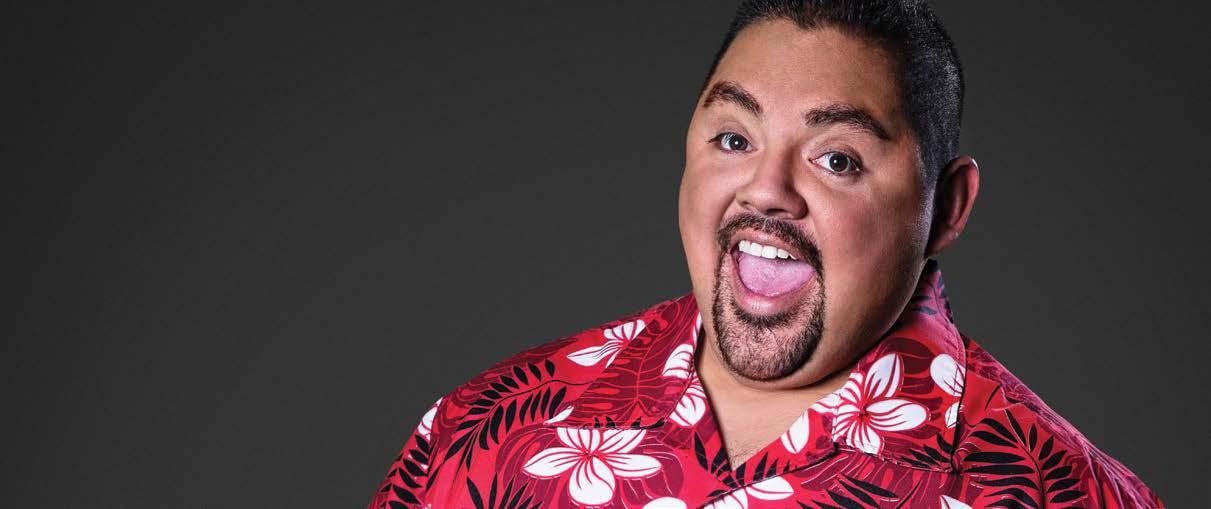
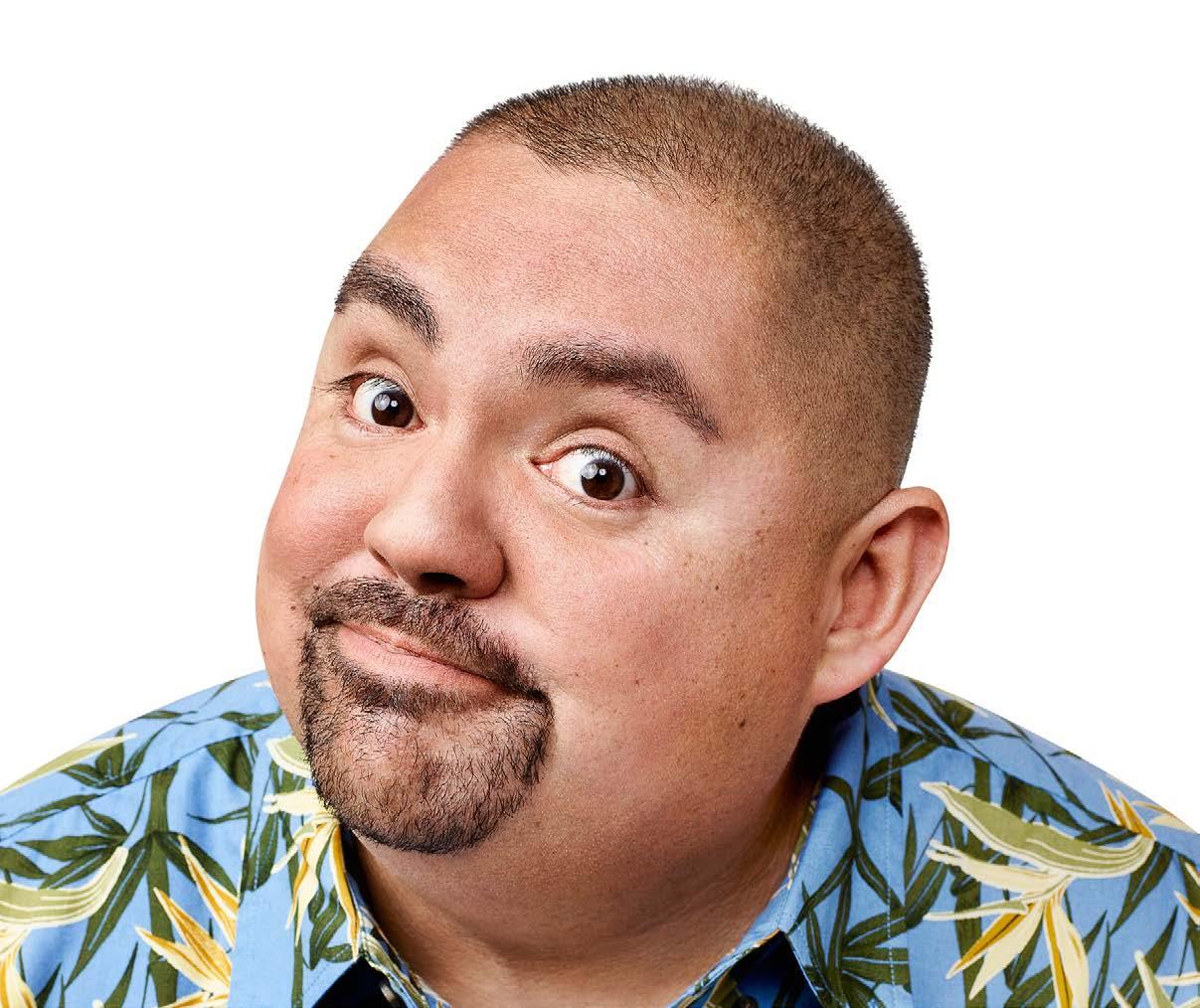
16
TLC: We know you are the youngest of six and grew up in poverty, explain how comedy helped you through your struggles at a young age?
GI: One of my earlier memories is entering a talent show and doing voices like Marvin the Martian and Mickey Mouse. I knew I could get a laugh and it would bring joy to people. It was the first time I knew I could be funny and laughing always helps just about any situation.
TLC: We've read your mom didn’t support your idea of becoming a comedian. Where did your support system and encouragement come from?
GI: At first she was worried it would be a struggle, but as I became more and more successful, she supported me, of course.
TLC: You have managed to cross cultures and not just have the label of being a Latino comedian, but a comedian who happens to be Latino. On the show Cristela, it was touched upon that we are not just Latinos, but people who have talents. What advice would you give others who are trying to prove themselves by their talent and not just their ethnicity or whatever stereotype/ label people want to place on us?
GI: The best advice I can give is to be yourself and tell your story. At the end of the day we are all just humans, hopefully, trying to be good. My act over the last few years has been about being a father, a boyfriend, a friend and a person with struggles - things that people can relate to. It took me a while to get out of being labeled just a "Latino comedian" - I think my material showed that.
TLC: Are you ever faced with the problem or serious situations where people don’t take you seriously thinking you are kidding?
GI: No, my onstage and offstage personas are different. I'm not a comedian that is "ON" all the time. I can turn it "OFF."
TLC: Is there any topic or character you don’t like to perform about?
GI: There are a few things that I don't touch in my act. Sports, politics and religion. I avoid these topics, because they are the quickest way to divide a room.
TLC: You recently lost weight for your health, what advice do you have for those going through similar issues?
GI: There isn't really a science to this. Eat healthier and work out more. When I am home I meet with my trainer 3 times a week and she helps keep me in check. Make a goal and don't "try" to reach it. Do it.
TLC: What has been your most epic and memorable show to date?
GI: There are too many to count. I have performed in so many different countries and venues, they all have a special place in my heart. A few that stand out would be Madison Square Garden in NYC, filming my stand-up film "The Fluffy Movie" at SAP Arena and The Sydney Opera House in Australia.
TLC: One thing we admire about you is how you help other comedians showcase
their talent, what makes you such a generous person when that's not really the norm in such a 'Me First' business like the entertainment field?
GI: I always believe in being kind to everyone that is kind to you.
TLC: What are you looking to accomplish in the future now that you have traveled the world, been in the movies, and tv shows, what's next for Gabriel Iglesias?
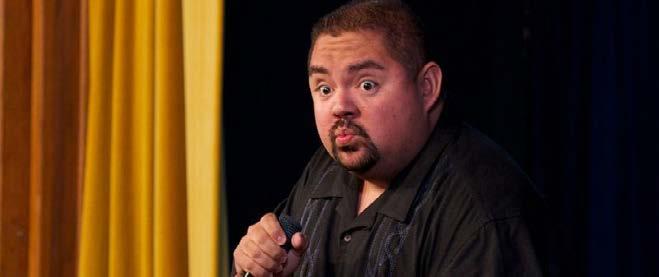

GI: Oh man, there are a lot of irons in the fire. My voice will appear in the animated film, "Norm of the North" in theaters January 15. I'm starting to film season 2 of "Fluffy Breaks Even" which will premiere on FUSE in April 2016. In March, I will also be filming a pilot, loosely based on my life OFF the road for ABC.
TLC: You start a lot of jokes with “Martin and I” what's up with that Bromance? How long has it been going? Where did it start? More importantly, who's the girl of the relationship?
GI: Martin and I have been friends for too many years, we met doing stand up and probably met at a hole in the wall bar or club. He keeps life interesting. The girl of the relationship is the one with longer hair.
Fluffy will be performing in Reading at the eagle Theater (Santander Arena) on April 21, 2016, Wilkes-Barre at the Mohegan Sun Arena on April 22, 2016, and in Pittsburgh at the Petersen events Center on April 23, 2016.
17
“
The best advice I can give is to be yourself and tell your story. ”
G abriel "F l UFFY"
i Glesias
La Revista The Latino Connection se enorgullece en presentar al comediante, actor y hombre de bien, Gabriel “Fluffy” Iglesias. Fluffy comienza el 2016 como un hombre muy ocupado, ya que tiene su gira "Fluffy Breaks Even", una película de dibujos animados "Norm of the North", y mucho más. Hasta se puede encontrar a Fluffy en Facebook, donde presenta otros comediantes talentosos. Nos alegramos de que Fluffy tenga tantos proyectos, porque no nos cansamos de él.
TLC: Sabemos que eres el menor de seis, y creciste en la pobreza. explica ¿cómo la comedia te ayudó en tus batallas en la juventud?
GI: Uno de mis más remotos recuerdos es haber hecho voces como las de Marvin el Marciano y Mickey Mouse en un concurso de talentos. Sabía que podía hacer reír y proporcionar alegría a la gente. Esa fue la primera vez que supe que podía resultar cómico y que reír siempre ayuda en casi todas las situaciones.
TLC: Leímos que tu madre no apoyaba tu idea de hacerte comediante. ¿De dónde surgió tu sistema de apoyo y tu ánimo?
GI: Al principio, a ella la preocupaba que eso fuera una lucha, pero a medida que iba haciéndome más y más exitoso, ella me apoyó, por supuesto.
TLC: Has tenido que manejar culturas cruzadas y no sólo tener una etiqueta de ser comediante latino, sino un comediante que, casualmente, es latino. en el programa Cristela, se mencionó de pasada que no sólo somos latinos, sino gente con talentos. ¿Qué consejo darías a otros que están probando por su talento y no sólo por su etnia o cualquier estereotipo/etiqueta que la gente quiera colocarnos?
GI: El mejor consejo que puedo darles es que sean ellos mismos y cuenten su historia. Al final de la jornada, todos somos apenas humanos, con suerte, tratando de ser buenos. Mi actuación de los últimos años ha sido ser padre, novio, amigo y una persona con batallas – cosas con las que la gente puede relacionarse. Me tomó un buen rato quitarme la etiqueta de “comediante latino” – Creo que mi material lo mostró.
TLC: ¿Has enfrentado alguna vez el problema o la situación grave de que la gente no te toma en serio porque piensa que estás bromeando?
GI: No, mis personajes en escena y fuera de escena son diferentes. No soy un comediante “ACTIVO” todo el tiempo. Me “DESCONECTO”.
TLC: ¿Hay algún tema o personaje sobre el cual no te gustaría actuar?
GI: Hay algunas cosas que no toco en mis actuaciones. Deportes, política y religión. Evito esos temas, porque son la forma más rápida de dividir un espacio.
TLC: Recientemente, perdiste peso por tu salud. ¿Qué consejo tienes para aquellos que están en asuntos similares?
GI: Eso no tiene ciencia, realmente. Comer más saludable y ejercitar más. Cuando estoy en casa, me reúno con mi entrenador 3 veces por semana y ella me ayuda a mantenerme controlado. Haz una meta y no “trates” de alcanzarla. Alcánzala.
TLC: ¿Cuál ha sido tu presentación más épica y memorable hasta la fecha?
GI: Son demasiadas. He actuado en tantos países y lugares, que todos tienen un lugar especial en mi corazón. Algunos que sobresalen serían el de Madison Square Garden en NYC, filmar mi película de stand-up "The Fluffy Movie" en la SAP Arena y The Sydney Opera House en Australia.
TLC: Una cosa que admiramos de ti es cómo ayudas a otros comediantes a exhibir su talento. ¿Qué te hace tan generoso, cuando en realidad ésa no es la norma en un negocio tan “yo primero” como el entretenimiento?
GI: Siempre creo que ser amable con los demás es ser amable contigo mismo.
TLC:¿Qué quieres cumplir en el futuro, ahora que has viajado por el mundo, has estado en películas y programas de televisión, qué sigue para Gabriel Iglesias?

GI: Hombre, hay muchos asuntos entre manos. Mi voz aparecerá en la película animada "Norm of the North" en cines desde el 15 de enero. Estoy empezando a rodar la segunda temporada de "Fluffy Breaks Even" que se estrenará en FUSE en abril de 2016. En marzo, también estaré filmando un piloto, a grandes rasgos, basado en mi vida PRIVADA para ABC.
TLC: Comienzas muchos chistes con “martín y yo”. ¿Qué pasa con ese bromance? ¿Cuánto tiempo lleva? ¿Cuándo empezó? Y, lo más importante, ¿quién es la chica de la relación?
GI: Martín y yo hemos sido amigos durante muchos años, nos conocimos haciendo stand-up y probablemente nos encontramos en un hoyo en la pared de un bar o club. Hace la vida interesante. La chica de la relación es el que tiene el pelo más largo.
Fluffy se presentará en Reading en el eagle Theater (Santander Arena) el 21 de abril de 2016, en Wilkes-Barre, Mohegan Sun Arena, el 22 de abril de 2016, y en Pittsburgh, en el Petersen events Center, el 23 de abril de 2016.
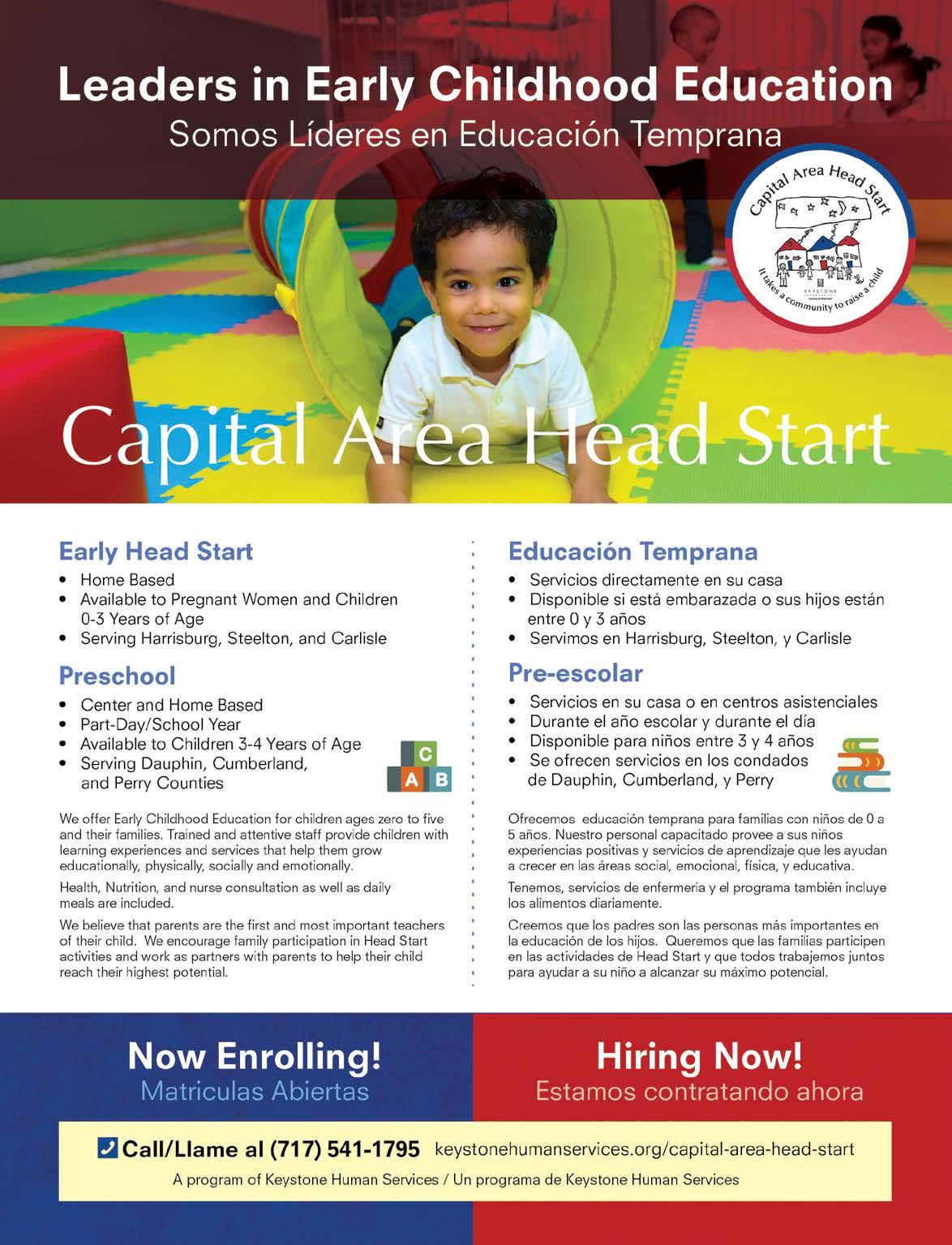
18 Español
TLC PROFUNDIDAD ex CLUSIVA


i a M a pro UD a F ro-la T i N a
My name is Raquel and I'm from the south side of Chicago.
I am Afro-Latina. I am a very proud Afro-Latina!

Some may ask why do you choose to label yourself? What does it mean to be an Afro-Latina? Who do you think you are? I'll get to the last question shortly, but let's discuss what it means to be Afro-Latino/a.
As stated in the introduction of “The Afro-Latin@ Reader: History and Culture in the United States,” Afro-Latino/a identity is defined as “…people of African descent in Mexico, Central and South America, and the Spanish-speaking Caribbean, and by extension those of African descent in the United States whose origins are in Latin America and the Caribbean.”
When I get questions about my identity I want to scream, ‘Learn from history! Did you know that there were more African slaves taken to South America and the Caribbean than the United States? Did you know we are a mixture of races and cultures?’
There are many Latinos with visible African roots, but they often deny it. The reason I use the term Afro-Latina is to celebrate who I am. Can I be proud of who I am?
Growing up on the south side of Chicago was different because there were no other Black Latinos/as where I lived; everyone was always inquisitive about my background. Perhaps it would have been different if I lived in New York, where it is more diverse. However, living in Chicago was not the same because most of the neighborhoods were segregated.
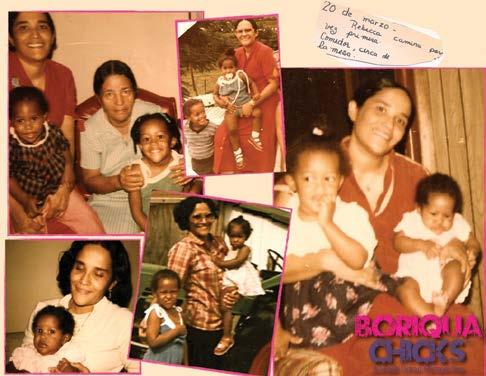

When I was younger I often visited Puerto Rico and it was normal to see Puerto Ricans who had different skin tones, eye colors, and hair textures. They spoke Spanish. They were Boricua. However, when I would return to my specific neighborhood in Chicago, to the mainland, our idea of what represented Latino/a identity was very limited. I rarely saw Black Latinos/as on television, in movies, or magazines—specifically positive representations. As I became older, I learned of how Black Latinos were not only invisible in the United States, but oftentimes they experienced discrimination in Latin America and the Spanish-Speaking Caribbean.
Five years ago I started the blog, BoriquaChicks.com, because I wanted to read about celebrities and everyday people who owned their identity and were proud of their culture. It was created to highlight those individuals like myself, Afro-Latinos/as who needed an online space to explore who they were and to question mainstream media depictions and stereotypes of Latino/a identity. While Afro-Latina is a label, it accurately captures who I am (as well as the thousands of other beautiful men and women who read my blog). As a Latina I feel comfortable embracing my blackness. No matter my physical appearance, no matter the evidence in food, language, music, and history, it is deeper than that…my soul screams that I am AFRO-LATINA and proud of it.
20
FROM RAQU e L PARHAM , CR e ATOR OF BORIQUACHICKS . COM
soY U N a orGUllosa aFro-laTi N a

Me llamo Raquel y soy de la zona sur de Chicago. Soy afro-latina. ¡Soy una afro-latina muy orgullosa!
Algunos se preguntarán por qué elijo auto-etiquetarme. ¿Qué significa ser afro-latina? ¿Quién crees que eres? Iré a la última pregunta en breve, pero discutamos lo que significa ser afro-latina.
Como dice en la introducción de “El lector afro-latino: Historia y cultura en los Estados Unidos” (The Afro-Latin@ Reader: History and Culture in the United States), la identidad afro-latina se identifica como “…gente de ascendencia africana en México, Centro y Sur América, y el Caribe hispano y, por extensión, aquellos descendientes de africanos en los Estados Unidos cuyos orígenes están en América Latina y el Caribe”.
Cuando me preguntan sobre mi identidad, quiero gritar: “¡Aprendan de la historia! ¿Sabían que llevaron más esclavos africanos a América del Sur y el Caribe que a los Estados Unidos? ¿Sabían que somos una mezcla de razas y culturas?”
Hay muchos latinos con raíces africanas visibles, pero a menudo lo niegan. La razón por la que uso el término afro-latina es para celebrar quién soy. ¿Puedo sentir orgullo de ser quien soy?
Crecer en la zona sur de Chicago fue diferente porque no había otros latinos negros donde yo vivía; todos fueron siempre inquisitivos sobre mis antecedentes. Quizás habría sido diferente si yo viviera en New York, donde hay más diversidad. Sin embargo, vivir en Chicago no era lo mismo porque la mayoría de los barrios estaban segregados.
a la izquierda, con su hermana, Rebecca
Cuando era más joven, visitaba Puerto Rico con frecuencia y era normal ver puertorriqueños con tonos de piel, colores de ojos, y texturas de pelo diferentes. Hablaban español. Eran boricuas. Sin embargo, cuando yo quería regresar a mi barrio específico en Chicago, a tierra firme, nuestra idea de lo que representaba la identidad latina era muy limitada. Rara vez vi latinos negros en televisión. A medida que crecí, aprendí cómo los latinos negros no sólo eran invisibles en los Estados Unidos, sino que a menudo experimentaban discriminación en América Latina y en el Caribe hispano.

Hace 5 años, inicié el blog BoriquaChicks.com, porque quería leer sobre las celebridades y la gente del montón que poseía su identidad y estaban orgullosos de su cultura. Se creó para resaltar individuos como yo. Afro-latinos que necesitaran un espacio virtual para explorar quiénes eran y cuestionar las representaciones y estereotipos de identidad latina de los principales medios. Aunque afro-latino es una etiqueta, capta con exactitud quién soy. (así como los miles de otros bellos hombres y mujeres que lo leen). Como latina, me siento cómoda asumiendo mi negritud. No importa mi apariencia física, no importa la evidencia en comidas, idioma, música e historia, es algo mucho más profundo… mi alma grita que soy AFRO-LATINA y estoy orgullosa de serlo.
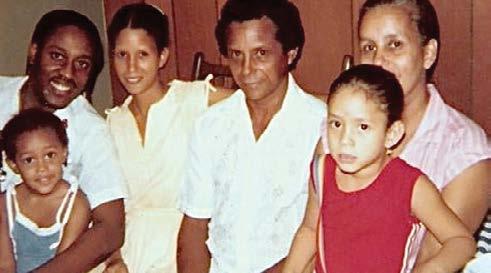
21 Español
OR : R AQU e L P
, C
ADORA D
B
C HICKS . COM
P
ARHAM
R e
e
ORIQUA
Raquel,

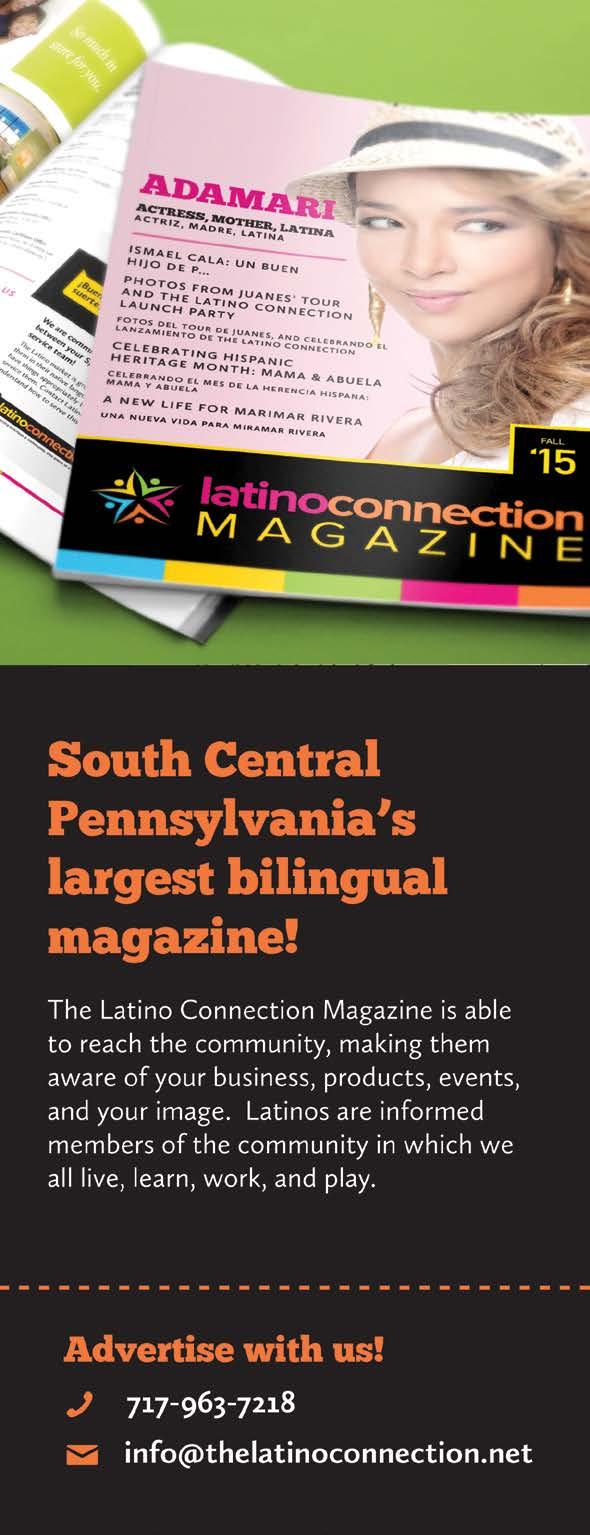


¿Sueñas con ser propietario de una casa? PHFA ofrece hipotecas que se ajustan a su presupuesto Tom Wolf, Governor | Brian A. Hudson, Sr., Executive Director & CEO Ayuda con información para la vivienda www.PHFA.org | 1-855-U-Are-Home (827 3466)
i s M ael Torres-Cas T ro D a D
Ismael Torres-Castrodad of San Juan, Puerto Rico, born five weeks prematurely, has been named the March of Dimes 2016 National Ambassador. He’s the first child from Puerto Rico to be named to this position in the history of the March of Dimes.
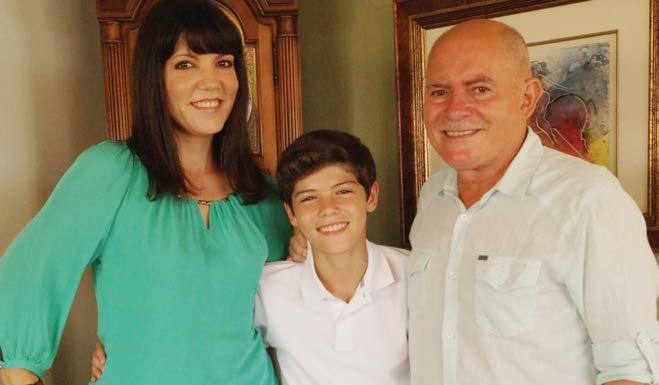
Ismael’s story emphasizes the serious and complex problem of late preterm birth, (between 34-36 weeks of pregnancy). His story will resonate with millions of families because more than 70 percent of all preterm babies are born in this late preterm time frame, the March of Dimes says. And like so many other mothers of preemies, Isamari Castrodad did everything she could to have a healthy, full-term baby but Ismael still was born too soon.
Preterm birth is the number one killer of babies, and those who survive an early birth often face serious and sometimes lifelong health challenges, such as breathing problems, jaundice, developmental delays, vision loss, and cerebral palsy. Even babies born just a few weeks too soon have higher rates of death and disability than full-term babies.
After being hospitalized during her pregnancy for having low amniotic fluid, Ms. Castrodad turned to the March of Dimes to learn more about her condition. She says the information gave her confidence to ask more questions at her next visit with her
doctor about her pregnancy and the tests she might need. She asked to have her amniotic fluid re-checked, and it was found to be dangerously low again. Ismael was born 48 hours later by emergency c-section. Six days after he was discharged from the hospital, he developed jaundice as well as respiratory syncytial virus (RSV), a lung infection, and pneumonia, and had to be re-hospitalized.
Today, Ismael is an active 13-year-old who excels in school and loves playing soccer and singing. He has asthma, but no longer requires daily treatment for it. He enjoys working as an “assistant producer” for his mother’s TV show, "Mas Con Isamari Castrodad" (“More with Isamari Castrodad”). Most of all, Ismael loves sharing his story, his parents, say. During his year as National Ambassador, the family will travel the USA, compliments of United Airlines, to tell their story and support the March of Dimes mission to improve the health of babies in both English and Spanish.
When Isamari Castrodad tells her story, she emphasizes that women must develop an open dialogue with their doctors and not to be afraid ask questions and advocate for themselves. She often speak outs about the importance of preconception care and how women can educate and empower themselves even before they become pregnant. She has been Chair of the March of Dimes in Puerto Rico, and served as their March for Babies 2013 Chair.

The March of Dimes National Ambassador Program is an annual campaign, started in 1946, that puts a face on the March of Dimes mission. United Airlines will continue to serve as the official airline sponsor of the March of Dimes National Ambassador Program for the 11th consecutive year.
The March of Dimes is the leading nonprofit organization for pregnancy and baby health. For more than 75 years, moms and babies have benefited from March of Dimes research, education, vaccines, and breakthroughs. For the latest resources and information, visit marchofdimes.org or nacersano. org. Find them on Facebook and follow them on Twitter.

23
TH e FIRST MARCH OF DIM e S AMBASSADOR FROM PU e RTO RICO
i s M ael Torres-Cas T ro D a D
Después de haber estado hospitalizada durante su embarazo por escasez de líquido amniótico, la Sra. Castrodad buscó orientación sobre su situación en March of Dimes. Afirma que recibir información le dio confianza para hacerle más preguntas a su médico en la siguiente consulta por el embarazo y solicitar las pruebas que pudieran ser necesarias. Solicitó una nueva verificación del líquido amniótico y el resultado mostró que se encontraba peligrosamente bajo. Ismael nació 48 horas después por una cesárea de urgencia. Seis días después del alta del hospital, Ismael desarrolló ictericia y virus sincitial respiratorio (RSV, por sus siglas en inglés), una infección pulmonar, y neumonía, y tuvo que volver al hospital.
Hoy, Ismael es un chico activo de 13 años con excelente desempeño escolar que ama jugar fútbol y cantar. Tiene asma, pero ya no requiere de tratamiento diario. Le encanta trabajar como "asistente de producción" del programa de TV de su mamá, "Más Con Isamari Castrodad". Pero sobre todo, dicen sus padres, a Ismael le gusta contar su historia. Durante su año como Embajador Nacional, la familia recorrerá los Estados Unidos gracias al patrocinio de United Airlines a fin de narrar su historia, en inglés y español, y apoyar la misión de March of Dimes de mejorar la salud de los bebés.

Ismael Torres-Castrodad de San Juan, Puerto Rico, nacido cinco semanas antes de tiempo, ha sido nombrado Embajador Nacional 2016 de March of Dimes. Es el primer niño de Puerto Rico en ser elegido como embajador en la historia de March of Dimes.
La historia de Ismael enfatiza el grave y complejo problema del nacimiento prematuro casi a término (entre las semanas 34 y 36 del embarazo). Millones de familias se identificarán con su caso, ya que más de 70% de todos los bebés prematuros nace en este marco temporal denominado prematuro casi a término, señala March of Dimes. Además, al igual que tantas otras madres de prematuros Isamari Castrodad hizo todo lo que estuvo a su alcance para dar a luz a un bebé sano que hubiese llegado a término completo; pese a ello, Ismael nació antes de tiempo.
El nacimiento prematuro es la causa principal de mortalidad infantil y los bebés que sobreviven un nacimiento prematuro suelen enfrentar problemas serios de salud que pueden durar toda la vida, entre ellos problemas respiratorios, ictericia, retraso en el desarrollo, pérdida de la vista y parálisis cerebral. Incluso los bebés que nacen tan solo unas cuantas semanas antes de tiempo muestran mayores índices de mortalidad y discapacidad que aquellos que llegan a término completo.
Cuando Isamari Castrodad narra su historia, subraya que las mujeres deben desarrollar un diálogo abierto con sus médicos y no tener miedo de plantear preguntas e interceder por sí mismas. Suele hablar de la importancia de los cuidados previos al embarazo y de la forma en que las mujeres pueden obtener información y empoderarse incluso antes de quedar embarazadas. Ha sido presidenta de la Junta de Directores de March of Dimes en Puerto Rico y fue presidenta del evento la Marcha por los Bebés en Puerto Rico en el 2013.
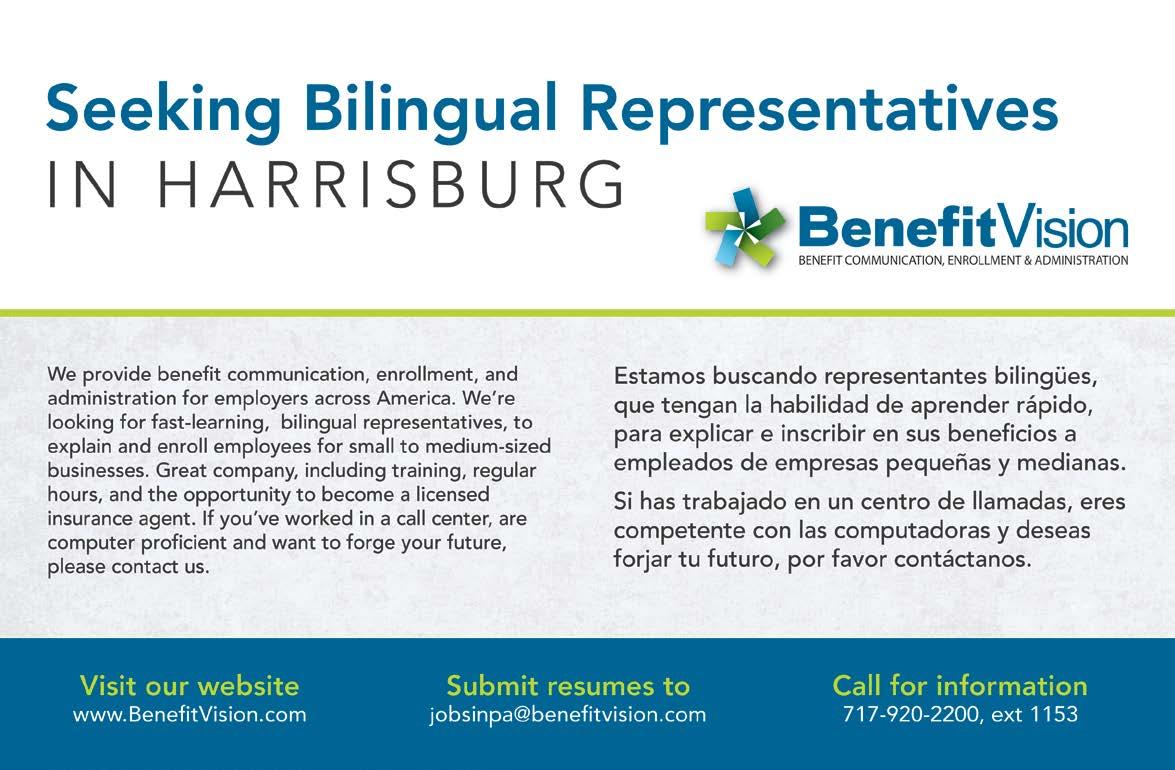
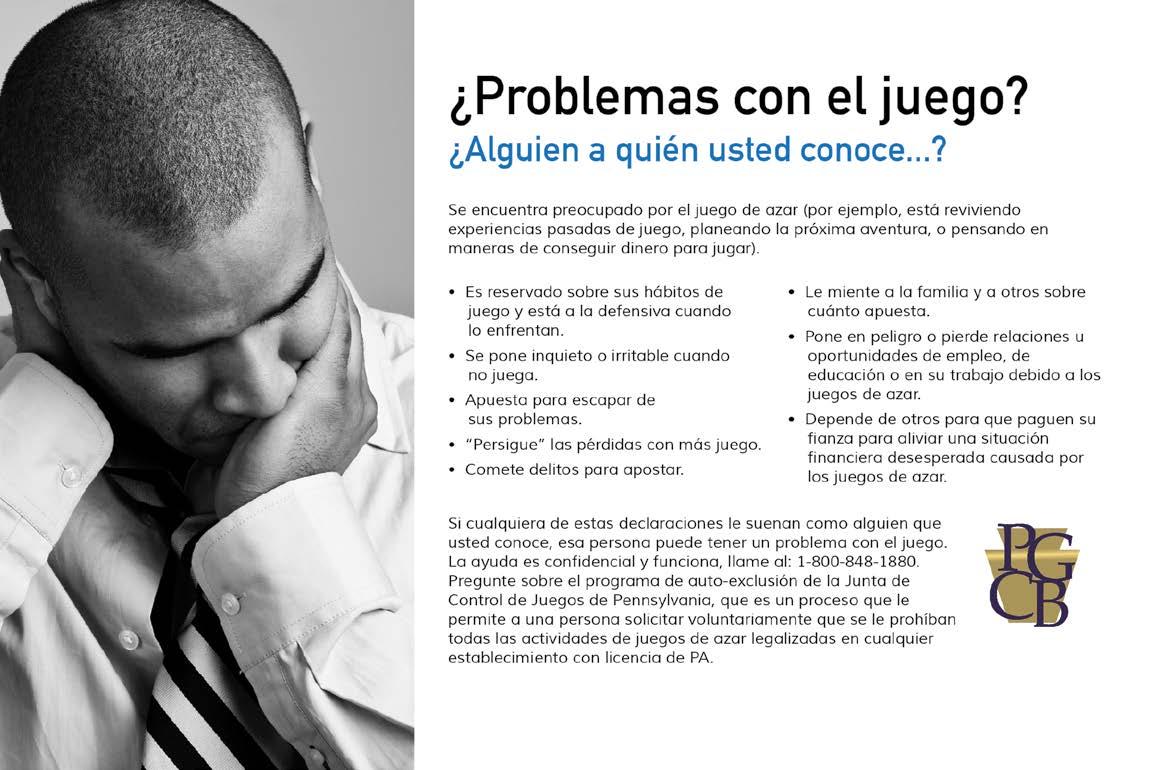
El Programa Embajador Nacional de March of Dimes es una campaña anual, fundada en 1946, que da rostro a la misión de March of Dimes. United Airlines seguirá operando como aerolínea patrocinadora oficial del Programa Embajador Nacional de March of Dimes por undécimo año consecutivo.
March of Dimes es la organización no lucrativa líder en el ámbito de la salud del embarazo y los bebés. Durante más de 75 años, las madres y sus bebés se han beneficiado de las investigaciones, los programas educativos, las vacunas y los hallazgos de March of Dimes. Para información y materiales más recientes, visite marchofdimes.org o nacersano. org. Encuéntrenlos en Facebook y síganlos en Twitter.

24 Español
eL PRIM e R NI ñ O D e P U e RTO R ICO e L e GIDO COMO e MBAJADOR D e M ARCH OF D IM e S


a s K pU ra!
Pura Rivera dabbles on the side as her own personal online investor and The Latino Connection Magazine has decided to ask our in-house financial hobbyist some questions as to how she got started.

TLC: Hey Pura, Can you give us a little background on what made you decide to invest online? What kind of financial background do you have?
Pura: So here is my official disclaimer, I am a complete novice. This is a hobby and interest of mine. I am not providing any sort of advice, this is just my simple story of how I decided to learn more about stocks and online investment. When I was a kid, I remember that my mom used to have me look at stocks in the newspaper, stocks like Disney and McDonald’s to track them for fun to see if they increased or reduced over a period of time. In the past couple of years, I decided that I was the only one I trusted to either increase my money, or lose it. I didn’t want to put my hard earned money in anyone else’s hands. Look what happened to all of those people who lost money in the Ponzi scheme. They trusted someone with their money and lost dearly.
TLC: How do you decide in which companies to invest?
Pura: I look at companies that are popular. Where do you and your friends shop? What has innovation? What is in the heart of America, something that we can’t live without like our Big Box stores. I listen to the news and online articles to see how specific businesses are doing. The ones that are having issues, I stay far away from those. I also look at what the millionaires like Warren Buffett invest in and what Jim Cramer says during his “Mad Money” shows on CNBC. Talk to your kids, find out what the hottest, greatest and latest things are. My 13 year old insisted that I purchase Disney shares and they are doing well.
TLC: What kind of software/hardware should an online investor have?
Pura: You can pick from many platforms. I personally picked www. etrade.com because it was easy for me to understand how to use it. It gives me updates about the companies I invest in, it provides me with articles on the specific stocks I have. I am also able to buy just 1 share if I want. You want to research how much a company will charge you to purchase and sell shares. A great comparison site is http://www.nasdaq.com/investing/online-brokers/ which features top online brokers.
TLC: What are the expectations of online investing? Can we get rich quick?
Pura: Absolutely not. I had a friend who was desperate to make some quick money, this isn’t the place for it. It’s a process of patience and vigilance. When Facebook went public and started offering stocks, I bought. A friend bought but panicked and sold very quickly because the stock wasn’t performing well and at one point was dropping drastically. However, I followed my intuition- I thought “everyone I know uses Facebook”. The stock tripled from what I paid for it. I had to be patient. This is a long term multiyear process. This is a marathon not a sprint.
TLC: What are the pitfalls/risks? We've heard people have lost all their savings. How can we protect ourselves from that happening?
Pura: First, before you look at stocks, make sure you have at least 8 months of money saved to cover living expenses to cover any unexpected emergencies or job loss. I also suggest that you invest in your retirement savings. When I have a couple of chavitos left over, I then decide to invest them. There is always risk involved. You will likely lose money. I have picked some duds and eventually sold them for less than what I paid for them. You have to be vigilant and understand when you should stay and when you should sell to minimize how much you lose.
TLC: May we ask what is the most you have earned investing?
Pura: Well, I bought Google stock at $260 and it is now worth over $700 per share. Not bad for a novice. It’s that Puerto Rican gut that I follow, the special powers I inherited from my ancestors and who doesn’t love Google! But in reality you don’t have cash in hand until you actually sell your shares.

TLC: Do you feel there is a better time of year/day to invest and if so why?
Pura: What I have observed is that when there is a crisis internationally, the stock market drops and that can be an opportunity to invest. Remember, don’t panic during this time with your investments, they are likely to go back up.
TLC: Do you recommend any books for beginner investors to educate themselves on the subject?
Pura: I listen to the gurus of investment, Suze Orman, www. suzeorman.com and el loco Jim Cramer on www.cnbc.com/madmoney/. Look at magazines like Money Magazine too. Don’t trust the guy who tells you he can double your investments. What does mami say… if it sounds too good to be true, RUN!
THANKS PURA! We feel smarter and ready to get our online investing on! Okay, maybe not so fast a little more research, but you have definitely inspired us.
26
ARN MOR e ABOUT ONLIN e INV e STING
Le
p re GUNT ale a pU ra!
Pura Rivera incursionó como su propia inversionista personal “online” The Latino Connection Magazine decidió hacer unas preguntas a nuestra entusiasta financiera, por ejemplo, cómo empezó.
TLC: Pura, ¿puedes darnos un pequeño antecedente sobre lo que te decidió a invertir por Internet? ¿Qué tipo de antecedentes financieros tienes?
Pura: Aquí va mi descargo oficial: soy novata total. Es un pasatiempo y un interés mío. No estoy dando ninguna clase de consejos, ésta es apenas mi simple historia de cómo decidí aprender más sobre valores e inversiones por la red. Cuando era niña, mi mamá acostumbraba a ponerme a mirar los valores en los periódicos, valores como los de Disney y McDonald, para rastrearlos por diversión y ver si crecían o disminuían en un período de tiempo. En los últimos dos años, decidí que yo era la única persona en quien confiaba, ya fuera para aumentar mi dinero o perderlo. No quería poner mi dinero ganado con tanto esfuerzo en las manos de nadie más. Miren lo que pasó a todos los que perdieron dinero en el esquema Ponzi. Confiaron su dinero a alguien, y perdieron muchísimo.

TLC: ¿Cómo decides en qué compañías invertir?
Pura: Busco las compañías que son populares. ¿Dónde compran tú y tu amigo/a? ¿Qué tiene innovaciones? Lo que está en el corazón de América, algo sin lo que no podemos vivir como nuestras tiendas Big Box. Oigo las noticias y los artículos en Internet para ver cómo van determinados negocios. Me mantengo alejada de los que tienen problemas. También veo en qué invierten millonarios como Warren Buffett y lo que dice Jim Cramer durante sus programas “Mad Money” en CNBC. Hable a sus hijos/as, averigüe cuáles son las cosas más calientes, más grandiosas y más recientes. Mi hij(¿o/a?) de 13 años insistió en que yo comprara acciones en Disney y están funcionando bien.
TLC: ¿Qué programas debe tener un inversionista en línea?
Pura: Puedes tomar de muchas plataformas. Personalmente, yo escogí www.etrade.com porque me fue fácil entender cómo usarla. Me da actualizaciones sobre las compañías en las que invierto, me proporciona artículos sobre los valores específicos que tengo. También puedo comprar 1 sola acción, si quiero. Una quiere investigar cuánto nos cobrará una compañía por comprar y vender acciones. Un gran lugar de comparación es http://www. nasdaq.com/investing/online-brokers/ que presenta los mayores corredores “online”.

TLC: ¿Cuáles son las expectativas de invertir por la red? ¿Podemos hacernos ricos rápidamente?
Pura: De ninguna manera. Yo tenía un amigo desesperado por dinero rápido. Este no es el lugar para eso. Cuando Facebook se hizo público y empezó a ofrecer valores, yo compré. Un amigo compró pero entró en miedo y vendió demasiado pronto porque los valores no se comportaban bien y en un punto estaban bajando drásticamente. Sin embargo, yo seguí mi intuición –pensé: “toda la gente que conozco usa Facebook”. Los valores se triplicaron de lo que pagué por ellos. Tuve paciencia. Este es un proceso a largo plazo de varios años. Esto es una maratón, no una carrera de velocidad.
TLC: ¿Cuáles son los inconvenientes/riesgos? Hemos sabido de gente que ha perdido todos sus ahorros. ¿Cómo podemos protegernos de que eso ocurra?
Pura: Primero, antes de ver los valores, asegúrate de tener al menos 8 meses de dinero ahorrado para cubrir los gastos de supervivencia, cualquier emergencia o pérdida del empleo. También sugiero que inviertas en tus ahorros de retiro. Cuando tengo un par de chelitos de más, entonces decido invertirlos. Siempre hay riesgos. Probablemente, perderás dinero. He tenido algunos fiascos y eventualmente los vendo por menos de lo que pagué por ellos. Tienes que vigilar y entender cuándo debes quedarte y cuándo debes vender para minimizar lo que pierdes.
TLC: Nos preguntamos, ¿Cuál es la inversión que más has ganado?
Pura: Bueno, compré valores en Google a $260 y ahora vale más de $700 cada acción. No está mal para una novata. Es ese instinto puertorriqueño que sigo, los poderes especiales que heredé de mis ancestros y quien no ama Google. Pero en la realidad, no tienes dinero en las manos hasta que en verdad vendes tus acciones.
TLC: ¿Sientes que hay un momento mejor del año/día para invertir y, en caso afirmativo, por qué?
Pura: Lo que he observado es que cuando hay una crisis internacional, el Mercado de valores se cae y eso puede ser una oportunidad para invertir. Recuerda, no tengas miedo durante este momento con tus inversiones, tienen probabilidad de volver a subir.
TLC: ¿Recomiendas algún libro para inversionistas principiantes para educarse sobre el tema?
Pura: Escucho a los gurús de las inversiones, Suze Orman, www.suzeorman.com y el loco Jim Cramer en www.cnbc. com/mad-money/. Mira las revistas como Money Magazine también. No confíes en el tipo que te dice que puede duplicar tus inversiones. Como dice mami, si suena demasiado bueno para ser cierto, ¡CORRE!
GRACIAS, PURA! Nos sentimos más hábiles y dispuestos para arrancar con nuestra inversion “online”. OK, quizás no tan rápido, un poco más de investigación, pero definitivamente, nos has inspirado.
27 Español Má S INFORMACI
ó N AC e RCA D e LA INV e RSI ó N e N L í N e A

l ove be G i N s b Y lovi NG
Y o U rsel F F irs T
By Sara Snow
What’s going on with women today? Where does this saying that “women are strong” come from? It is obvious that after the courtship, the wedding, women go through a phase in which helping them becomes less every day. Is it possible that there’s a misapprehension concerning the strength of women today? Being a strong woman does not mean not needing anybody’s help; it does not mean they are “omnipotent” and even less does it mean they are meant to have a family on their own and carry the weight of the world. Being a strong woman is to be wise, to share family responsibilities, and to know when to say “I need help”, to know that in life there will always be a time to make hard decisions, and we won’t always know when to show our poker face.
Women have evolved throughout history, occupying a position in society which our grandmothers once aspired to; independent women have reached a moment in their lives that through their work and effort, they have raised their children, provided them with a good home, and solid education for the future. In order for women to achieve this dream, they need to start working with the most important person in their life, their inner self; they need to discover their true worth and start loving themselves; loving themselves is what gives them strength to fight and reach any goal they’ve set their sights on, it drives to discover skills and qualities we were unaware of. Here is where the “strong” adjective that defines women as such comes from, because once woman recognizes her true value, the inner strength she develops -both physically and mentally- allows her to accomplish almost anything she wants.
Women need to be clear about the “strong” concept, they need to understand that their strength and value doesn’t translate to the capacity of doing everything on their own, and neither does it mean they need to prove the world how strong they are; women need to know themselves well inside and out, be sure of what they want, trust and never hesitate about their accomplishments, but moreover, know that no one will love them more than themselves.
This doesn’t mean women don’t need a partner, but need to acknowledge that we are our own greatest support, and find peace within our company.
Women walk with their head held high, because they love themselves and that is undeniable, they achieve their goals because they know they are capable of fulfilling any longing in their heart, woman are love, but only If they love themselves first. We can’t ignore the fact that there are many girls and women that have experienced abuse –physical or verbal- which leave scars that don’t fade easily, scars that leave marks and sometimes remain until their dying breath, scars that don’t heal unless treated by a professional; a strong woman is not weakened by this type of ordeal she seeks help and overcomes all. To keep quiet and put up with abuse will not help in any way; no one deserves to be abused. Being a woman and being physically weaker than men does not imply having to endure abuse, enduring abuse only means that the woman does not love herself.
It is best to get help, seek counseling that helps you assess the root cause of said behavior in your significant other or your loved ones; sometimes women don’t know that they have become the cause of another’s pain, thanks to this habit of not defending themselves and being convinced that this is the right way to act because it can affect their children, parents, friends and anyone else dear to them, that are aware of the endured abuse and how it hurts them to see their suffering.
By analyzing these scenarios, I want us to focus on this new year, and to try and prove ourselves our self-worth and how strong we are, and to know that we have within us the capacity to be professionals, mothers, wives, teachers of life, with character and wisdom, and that above all, we must love ourselves.
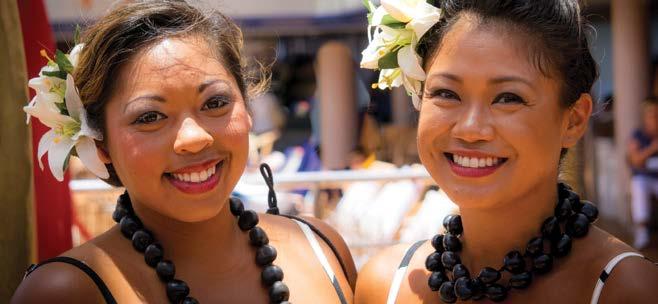

29
e l aMor CoMie N Za a M á ND o T e a T i MísMa
Por Sara Snow
¿Qué sucede con las mujeres de hoy en día? ¿De dónde proviene este adjetivo de que las mujeres son “fuertes”? Es notorio como luego del noviazgo, la boda, las mujeres pasan a una etapa en donde la ayuda a estas disminuye. ¿Será que existe un concepto equívoco sobre la fortaleza de la mujer? Ser una mujer fuerte no significa el no necesitar la ayuda de “nadie”, no quiere decir que es “un ser que todo lo puede” y mucho menos significa que está hecha para formar una familia sola y echarse todo el mundo encima. Ser una mujer fuerte es tener sabiduría, compartir las responsabilidades familiares, y saber decir necesito ayuda, reconocer que en la vida nos tocará tomar decisiones las cuales a veces serán difíciles, y que no siempre tenemos que poner el carácter de “soy fuerte” por delante.
Nosotras las mujeres hemos avanzado a través de la historia ocupando un lugar en la sociedad al cual nuestras abuelas soñaban algún día llegar, la independencia de la mujer ha llegado a un punto en el que con nuestro trabajo y esfuerzo hemos podido echar a nuestros hijos adelante, brindarles un hogar decente, y una buena educación para un mejor porvenir. Para la mujer poder llegar a lograr este sueño tiene que comenzar a trabajar con la persona más importante en su vida, que es ella misma, tiene que descubrir su valor y empezar a amarse a sí, el amor hacia su propio ser es el que da la fuerza para luchar y alcanzar cualquier meta que se proponga, nos hace descubrir que tenemos capacidades que incluso desconocíamos. De aquí nace este adjetivo que define a la mujer como alguien ”fuerte”, porque una vez que esta reconoce su valor desarrolla una increíble fuerza tanto física como mental que le permite lograr casi todo lo que se proponga.
La mujer debe tener claro el concepto de”ser fuerte”, entender que reconocer su fortaleza y valor no significa el poder hacer todo por sí sola, tampoco tiene que demostrarle a nadie que tan fuerte es, solo tenemos que conocernos muy bien por dentro y por fuera, estar seguras de lo que queremos, confiar y no dudar nunca de lo que podemos lograr, pero sobretodo, saber que nadie nos amará tanto como nosotras mismas.

Esto no significa que no necesitemos a una pareja pero debemos reconocer que somos nuestro mejor apoyo y encontramos paz en nuestra propia compañía.
La mujer camina con su cabeza en alto porque se ama y de eso no hay dudas, logra sus metas porque sabe que es capaz de cumplir
cualquier deseo que su corazón anhele, la mujer es amor, pero solo si se ama ella misma primero. No podemos ignorar el hecho de que existen niñas y mujeres abusadas las cuales han recibido ciertos daños físicos o verbales los cuales dejan traumas que no desaparecen fácilmente, son huellas que quedan marcadas y les quedan muchas veces hasta el final de sus vidas, cicatrices que muchas veces no sanan sino con ayuda profesional, una mujer fuerte no se deja debilitar por este tipo de situación, busca ayuda y la sobrepasa. El callar y aguantar los abusos no te ayudará de ninguna manera, nadie merece ser abusado, el ser mujer y ser físicamente menos fuertes que los hombres no implica tener que aguantar el abuso, el soportar esto significa que la mujer no se ama a sí misma.
Es mejor obtener ayuda, buscar consejería que le ayude examinar el porqué de tal comportamiento de su pareja o seres amados, a veces la mujer no sabe que ella también se ha convertido en la causa del dolor de otro ser humano gracias a que por la costumbre de esta no defenderse y estar convencida de que esa es la manera correcta de actuar pues puede afectar a sus hijos, padres, amigos, u otros seres queridos que tienen conocimiento del maltrato y a los que les duele ver el sufrimiento de esta persona.
Analizando estas situaciones quiero que nos enfoquemos en este nuevo año que se acerca y que nos esforcemos en demostrarnos a nosotras mismas nuestro valor y lo fuerte que somos y saber que tenemos la capacidad de ser profesionales, madres, esposas, maestras de la vida, con carácter y sabiduría y que debemos amarnos por encima de todo.
30
